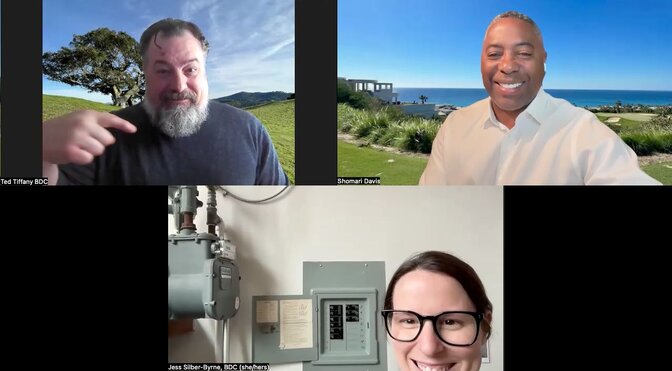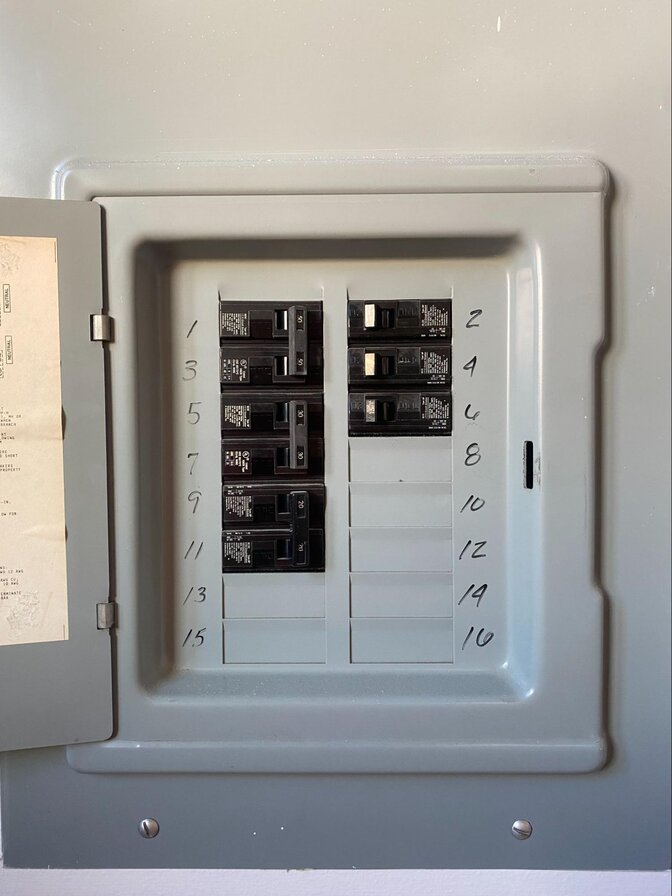
Meet the three BDC employees offering expert advice in this Q&A: Top left is Ted Tiffany, top right is Shomari Davis, and below is Jess Silber-Byrne.
What is an electrical panel?
Jess: Don’t judge me, but I need to start at the top. What is an electrical panel?
Shomari: An electrical panel is the distribution center for power in your home. It’s a device that brings electricity from your utility provider, then distributes it through wires grouped in circuits to different parts of your house. Typically, newer, more modern homes have a 200-amp panel. Older homes may have 100-amp or even 60-amp panels.
Amps, circuits, and breakers explained
Jess: Okay, time out already. What are amps? What are circuits?
Shomari: Amps measure the flow of electrical current. Circuits are groups of areas that are electrified together under a single circuit breaker. Circuit breakers are safety devices. If you are using too much power, the breaker’s job is to say “No more. You’re going to overheat this wire and burn it up.” So it trips, or turns off the electricity to that circuit.
Think about a modern kitchen. It usually has many separate circuits. You might have a refrigerator on one circuit, an oven on another, plus a couple of separate circuits for your countertop outlets — so you can plug in your blender, your coffee maker, and all of your devices without using too many amps and constantly tripping the circuit breaker.
How to read your electrical panel
Jess: Here’s my panel. This is like looking into a crystal ball for me. I don’t understand it. Can you “panelsplain” it to me?

Jess’ panel for a 2-bedroom, 1-bathroom apartment rental.
Shomari: I see circuits with 50 amps, 30 amps, 20 amps. You might think, Wow, that’s 100 amps right there! But it’s not additive—that’s not how a residential panel works. A home, unlike a commercial building, might have a 100-amp panel with multiple circuits wired at 15, 20, and even 40 amps. If you added them all up, the total would be over 100. And that’s because occupants of a home aren’t expected to use continuous electricity loads, at full capacity, at the same time.
Ted: Right. My additional unit has 180 amps worth of breakers on 100-amp service. So, if I was to use all of those at once, we’d have a problem.
Shomari: Now look at #6 in your panel. That’s a 15-amp circuit. Most circuits in a home are wired to deliver a standard 120 volts. Multiply your amps by volts to determine how much power, or watts, each circuit can handle. So, with 15 amps multiplied by 120 volts, you get 1,800 watts, and you can assume circuit #6 can only use devices that add up to 1,800 watts of power.
So, if #6 is running to your bathroom and you plug in a hairdryer, which uses about 1,000-1,200 watts, and then you turn on your curling iron, which might use 800 or more watts, then you might trip the breaker on #6.
Ted: The circuit breakers on your panel aren’t labeled in this photo. Here’s how you can learn what’s on each circuit: Turn on all the lights and a few appliances. Then shut off the circuit breakers and see which devices turn off. Make sure to turn off your computer before doing this, though, as a sudden power cut can damage it.
Shomari: Jess, your panel has a lot of unused capacity! So you could add more appliances without upsizing your panel.
When do you need a panel upgrade?
Jess: Well, that’s good to know! How can you determine if you should upsize your panel?
Ted: It’s different for every home and individual, depending on your starting point and your goals. Start by understanding where your panel is, how many breakers you have, how the circuits are organized, if they are labeled correctly, and if that work is up to code. All of that needs to be assessed by an electrician or a qualified whole-home contractor.
I should add: This is all evolving. Right now, you can electrify a small two-person household with two EVs on a smart panel with 100 amps. But once a home’s square footage starts going over, say, 2,500 square feet, you can’t do that without some sort of power monitoring.
Jess: What do you mean, ‘power monitoring?’
Ted: Power monitoring is helpful to determine if a circuit is overloaded. Power monitors clamp onto the circuit to measure load spikes, which are sudden or temporary increases in electrical demand, that result from different events or appliance use. They give you data on what devices are drawing power, how much, and when. Emporia has several examples.
How to avoid a full panel upgrade
Jess: Got it. Are there circumstances where homeowners would definitely need to upsize their panel?
Ted: A 4-bedroom, 3-bathroom house with multiple HVAC services, or enormous domestic hot water loads, will struggle to go fully electric on just 100 amps. And if you have a home with a 60-amp panel, then you probably need to upsize your panel.
Shomari: Yes. In those cases, you’ll want to upsize. In California, where I live, there are panel upgrade incentives for single-family homes with panels under 200 amps through TECH Clean California. There are also federal tax credits for residents in all states. The Switch Is On Incentive Finder shows all the incentives available to you based on your zip code.
Ted: If you’re not in a very large home and you’re working with 100 amps, then you can make some decisions to avoid panel upsizing.
Choose smart appliances
Jess: What kinds of decisions might those be?
Ted: Your appliances, to start. Think about your lifestyle. If you're replacing a gas stove, think: do I need a full induction range? Or would just a stovetop work? If you don’t use an oven much, you might opt for a 120-volt plug-in combination steam oven instead of a large, high-powered range. Ciarra has a countertop example with multiple functions for around $350. Nuwave has a $400 option on Amazon. For me, I don’t do professional-level cooking, so this could replace my microwave and give me more cabinet space at the same time.
Next, make decisions on improving efficiency. I’ll use myself as an example. I needed to electrify space heating in an additional unit. I asked my HVAC contractor, “How can I bring down the electrical load for HVAC?” We decided to air seal and insulate the unit. This reduced the heating and cooling load, and we could eliminate the need for adding electric resistance backup heaters, which would have put a huge strain on the panel.
Another decision: Can you use smart panels or circuit splitters?
Reduce HVAC load with efficiency
Jess: What are smart panels and circuit splitters?
Ted: A circuit splitter is a small device that lets you share power on a single outlet. NeoCharge has one that’s about $350.
A smart panel does this on a larger scale. It’s a digital electrical panel that gives you more control over how power is distributed, and it automatically manages loads. It can temporarily reduce power to your HVAC system to prioritize another appliance, or do whatever you tell it to do. And it has an off-grid mode. So, if you have solar and battery storage, you can program it to keep essential devices—like your refrigerator—running in a power outage. A SPAN panel, to use one example, costs about $3,500.
Jess: That sounds like a lot.
Try smart panels or circuit splitters
Ted: Well, compared to the cost of a panel and service upgrade, it looks good! If you learn it will take six months and $12,000 for the utility to upsize your panel and service wires, that’s a showstopper for a lot of people. That’s where you find yourself looking at things like the SPAN panel. I’d gladly pay for that instead.
Cost considerations
Jess: So what kind of costs are we talking about for a panel upsize, then?
Ted: Replacing your home’s electrical panel entirely can start at around $2,000, and you need approval from the utility. And in some cases, the utility might need to change the service wire that connects the electrical pole to your house. That’s a service upgrade. And that can cost much more.
Shomari: Right. In Pasadena, where I used to live, the city wants to get rid of overhead electrical wires. So, all new panel upgrades had to be ready to receive underground power lines in the future. This means homeowners or electricians had to install a combo service panel, which combines the main breaker and the meter socket in a single unit. And you have to dig a trench all the way from the side of your house where the panel is, out to the street where the city electrical vault is. That type of work can get expensive quickly.
Ted: There are other hurdles to be aware of. I’m looking at your panel right now, Jess. See how close your gas meter is to your electrical panel? That’s outdated. Codes now require this distance to be a minimum of 36 inches. So, if you owned this apartment, you’d need to move your gas meter and upgrade your panel. That’s more work and more money.
What to ask your contractor
Jess: OK, let’s say I brought a contractor over. What should I ask them?
Ted: Ask them:
- What’s the age and condition of my panel and my electric system?
- What is my panel capacity? Where do I find it on the panel?
- What is the service capacity coming into my house?
- Then, ask about your system, including the wiring in your home. Is it grounded, safe, and up to code?
Also, be aware that some contractors will automatically recommend a panel upgrade. I’d ask: “Do you do any evaluation on the existing loads? Will you complete an investigative analysis on the condition of my wiring and penal service? Or do you just recommend a service upgrade?”
Asking that question will give you an indication of how detailed they will be in their investigative efforts.
Shomari: Yes, exactly. You want that investigative effort. Ask your contractor how many more circuit spaces electrification will take up in your panel. If you can fit more into the panel you already have, then you know you don’t need an upgrade.
But if you don’t have space, you don’t have space. So, if you have a small 60-amp panel and you know you need to upgrade, ask right away: Should I go for 100 amps or 200 amps?
When upsizing, all new circuits should be properly grounded. Have your contractor check whether your current electrical system has proper grounding. Also, ask:
- Does my panel need to be a certain distance from the gas meter (like Ted mentioned)?
- Is my city planning to switch to underground power lines in the future (like in Pasadena)?
- Do I need a bigger service wire, and if so, how much will that cost?
- How long will it take for the city to approve my panel upgrade after I get a permit?
- Will both the city and the utility company inspect the work, or just one of them? In some places, you’ll need approval from both.
Jess: Any final advice for optimizing your 100-amp panel?
Ted: Ask those good questions! Investigate all of your options before getting into a panel and service upgrade process.
Shomari: Make sure to use tandem (double) breakers where possible to free up space for any new circuits you need to add, and to maximize your existing panel. Keep in mind that 240-volt circuits—like those for heat pumps and induction ranges—require two breaker slots. Identify and label each circuit to show what it controls and how much power it uses.

Shomari Davis is BDC’s Senior Manager of Workforce Development. Before joining the BDC, Shomari worked as a union-trained electrician and then a Business Representative for the International Brotherhood of Electrical Workers (IBEW) Local 11 in downtown L.A., South L.A. and Hollywood, for 17 years.

Ted Tiffany is BDC’s Senior Technical Lead. Before joining BDC, Ted worked for a top-level engineering firm focusing on building electrification design, from houses to hospitals, with a focus on technically challenging buildings.

Jess Silber-Byrne works on neighborhood-scale decarbonization at BDC. She is a renter adding electric appliances to her apartment who does not know anything about panels.